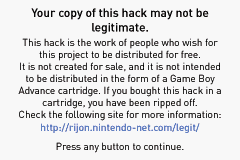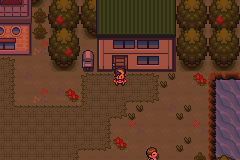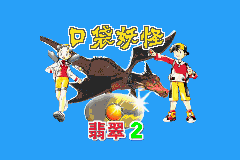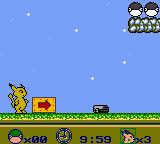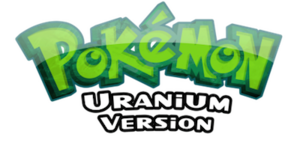ROM hack
- Pokémon Prism redirects here. For the TCG mechanic, see Prism Star (TCG).
- Jade redirects here. For the Key Item associated with Rayquaza, see Jade Orb.
ROM hacks, also known as hack games or ROM patches, are video games that have been edited or altered by enthusiasts. The hackers achieve this by changing the code of the Read-Only Memory of a published video game to create something new.
The core series Pokémon game system is considered very versatile and lends itself well to modification, giving hackers a lot of creative freedom together with a solid, well-tested game engine. These factors, as well as Pokémon’s notable popularity throughout the world, has lead to the creation of thousands of different games spanning multiple generations, ranging from minor adjustments to additional new features and, more and more frequently, entirely new fan-made Pokémon games. Though the core-series is by far the most popular series to hack, there are also many fan-created Pokémon games that do not use these as basis, and instead are, for example, modified versions of the Pokémon Mystery Dungeon series and Pokémon Conquest.
There is a distinction between ROM hacks and "bootleg games". These are unauthorised copies of published games which are sold to consumers, often flashed onto after-market game paks or game cards and lacking the official Nintendo Seal. However, since ROM hacks are often distributed over the Internet for free, they are regularly sold as bootleg games, usually against the hacker’s wishes. The reliability of these bootlegs are often poor, and has become such a problem that hackers have started to introduce warning screens into their games, cautioning users that if they paid for it, they may have been scammed.
History
Early Pokémon ROM hacks date back to the late 1990s with modified editions of Pokémon Red. These were often relatively minor adjustments such as sprite or dialogue changes, and would generally follow the flow of the original game. These early ROM hacks were infamous for being particularly crude in nature, ranging from swapping Pokémon and human sprites around to replacing the dialogue with obscene text.
This trend continued until the release of Pokémon Brown by user Koolboyman in the early 2000s, one of the most notable Pokémon hacks in history. This was the first hack to completely re-invent the game, with a brand new region and completely new plot. Later editions included an expanded Pokédex (including Pokémon from Generations II, III, and IV), additional dungeons and additional plot tweaks. It is one of the few completed hack games and was successful enough to warrant a sequel (Pokémon Prism, a Pokémon Crystal-based hack) and a Generation III version (Pokémon rijonAdventures) based on Pokémon FireRed.
Since Brown, Pokémon hacking’s notoriety has expanded exponentially, with developers creating many software tools for desktop operating systems to help create maps, edit sprites, graphics and even developing scripting languages specifically for the Pokémon game engine. It has also inspired many hackers to learn how to edit the games' source code directly (known as ASM hacking). Numerous hacks have been released, often using FireRed as a base, such as Pokémon ShinyGold, Pokémon Naranja and the Pokémon Ruby Destiny series, just to name a few. While directly editing the binary data of one of the games was previously necessary to create a ROM hack, it's now far more common to work from community decompilations of the games, as source code (Z80 assembly for Generations I and II, C thereafter) is far easier to write and debug.
There are many websites dedicated to Pokémon ROM hack development. Notable examples include Skeetendo, PHO, and PokéCommunity’s ROM Hack section, the largest known English-language Pokémon ROM hacking community. Many of these sites hold award nominations and ceremonies to showcase some of the best talents of their community.
Nintendo's stance on ROM hacks

|
This section does not yet meet the quality standards of Bulbapedia. Please feel free to edit this section to make it conform to Bulbapedia norms and conventions. Reason: needs better sources |
Nintendo is against the practice of ROM hacking and has taken action against it in the past, issuing DMCA takedowns to some ROM hacks.[1][2]
Game types
Pokémon ROM hacks tend to fall into five vague categories, though due to the huge versatility of the Pokémon engine, some hacks will transcend several categories at once.
Pokédex hacks

These hacks are designed to make all Pokémon available in-game, including first partner Pokémon, event Pokémon, version-exclusive Pokémon, and Pokémon that can only be obtained or evolved through trading, thus allowing the Pokédex to be fully completed in a single playthrough of the game. More advanced hacks will include Pokémon from later generations, often also adding the Fairy-type, newer moves and abilities, and other quality of life features to older games as well. They are often, though not always, named by simply appending the size of the National Pokédex (depending on the generation) to the end of the base game's name, as in "Pokémon Red 151" or "Pokémon Emerald 386". Such hacks will often not deviate too far from the official game story, and are often used in Nuzlocke runs and, more notably, for several runs in Twitch Plays Pokémon.
Difficulty hacks
These hacks, such as Pokémon Radical Red and Pokémon Expert Emerald, also rarely differ from official game in terms of story. They instead have a significantly higher difficulty than usually experienced in regular Pokémon games. They often include extended Pokédex availability and other quality of life features, much like Pokédex hacks. These types of games too are popular amongst Nuzlockers as an additional challenge on top of Nuzlocke rules. Many fans see Pokémon Black 2 and White 2’s Challenge Mode as an acknowledgement of these hacks, though no official link has been made.
ROM bases
These hacks are often designed to be used as a base for other ROM hacks, and often include major revisions to the game’s base code through ASM hacking to add new features such as additional types or a completely re-vamped tileset. Notable features include the introduction of a playable female character into Pokémon Gold, the addition of a Physical/Special split and the real-time clock into Pokémon FireRed, which gives way to a full Day/Night system, a feature that was missed by many fans in Generation III.
Another noteworthy feature is the development of the UPS patch format, which allows the expansion of Game Boy Advance ROM hacks from their original 16MB format to 32MB. This has the advantage of effectively doubling the space available for new maps and graphics, but means the game is only playable under emulation and will crash when played on official Nintendo hardware.
Language hacks

Since the core series games prior to Generation VI were regularly released first in Japan, sometimes months ahead of their international releases, amateur enthusiasts would often translate Japanese-language Pokémon games into English and other languages so they could be played by international audiences. Since the translation was often performed by one or a small group of people, the quality of these translations were often dubious to say the least, the most humorous example being Pokémon Vietnamese Crystal. Nonetheless, these hacks were generally translated well enough to be played and were very popular amongst YouTubers.
In recent years, the core series games have begun releasing simultaneously around the world in more languages and as a result the need for language hacks has somewhat diminished. It does still happen for languages that the Pokémon games are not yet available in, most notably Chinese prior to Generation VII.
Full/complete hacks
These hacks are complete overhauls of the games, with new characters, plots, regions, and features. They often overhaul the game’s graphics, incorporating those seen in later generation games including battle backgrounds, sprites, and map tiles. They will regularly include Pokémon, moves, and types from later generations, and will sometimes include brand new ones created by the hacker. Some hacks, such as ShinyGold and Liquid Crystal, are remakes of entire previously released games, in the same way that FireRed and LeafGreen were remakes of Red, Blue, and Yellow.
Because of the extraordinary amount of work involved by a voluntary hacker or hacking team, few of these games are finished in their entirety and are usually playable in the form of a beta. Most of the notable hacks below are considered to be part of this category.
Notable core series hacks
With the release of easy-to-use hacking tools for the core series games, there are thousands of ROM Hacks available. What follows is a few notable examples, each with a brief explanation.
Pokémon Quartz
Pokémon Quartz, created by Baro, is considered one of the first complete overhauled ROM Hacks. Though its story is very similar to the original Pokémon Ruby's story, it does have its own original story, locations, and characters. It was also one of the first to include custom tilesets, as well as a completely custom Pokédex of 368 original Pokémon (though they often reused canonical Pokémon's stats).
Pokémon ShinyGold
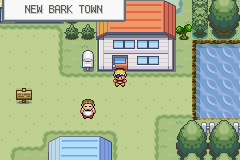
Pokémon ShinyGold was a Generation III remake of Pokémon Gold and Silver using the Pokémon FireRed engine, echoing how FireRed is a remake of Pokémon Red. Whilst not the first of its kind, it is amongst the most well-known Generation III hacks, despite it never leaving the beta stage. It is also one of the most illegally sold ROM hacks, with many bootleg versions of ShinyGold available as pre-patched ROMs or flashed game paks. ShinyGold's creator, username Zel, included a warning in later editions warning users about this problem and to demand their money back if they had paid for it.
ShinyGold is one of a number of Generation II remakes developed by hackers. Other examples include Pokémon Liquid Crystal and Pokémon CrystalDust, both of which include expanded areas and features, amongst others.
Pokémon Ruby Destiny series

Pokémon Ruby Destiny is a popular series of games based on the Pokémon Ruby engine created by PokéCommunity user destinedJaGold. The series consists of three completed games: Reign of Legends, Rescue Rangers, and Life of Guardians. This series is of particular note, as it is one of the longest running completed hack series available, particularly for its in-depth gameplay and plot. It, like other popular hacks, has even drawn interest from Let's Play creators. The series is also known for incorporating the Fairy type into the Generation III game engine, as well as a user-created "Chaos type", alongside several user-created Pokémon.
A fourth game in the series, Broken Timeline, was in development and would've involved the Eon duo, Latias and Latios, but development for the game has since been cancelled due to destinedJaGold losing interest after going through several plot changes to the story and never getting past the beta stage, and since been done with ROM hacking in general.
Moemon
Moemon (short for "Moekko Monsters", 萌え擬人化 ) is a prominent hack of Pokémon FireRed that changes all Pokémon into gijinka. It is a simple change of FireRed, but with additions such as the ability to catch the three first partner Pokémon, Eevee, and a mix of both LeafGreen and FireRed Pokémon (thus making it simpler to obtain all Pokémon). The game still receives a fair amount of attention, as a patch was released solely for the FireRed hack that updated both the sprites of the Pokémon as well as their menu sprites, functioning like DLC would for any game.
A ROM hack of Emerald has been released as well. Like the FireRed hack, it's a simple change of Emerald, replacing all Pokémon with ginjika counterparts, however, a few aesthetic changes have been applied to both Route 101 and Littleroot Town, adding many puddles to the town, and the Oran Berry has, curiously, been renamed the "Weed Berry", possibly for comedic effect.
Moemon received a short burst of fame when gaming site Kotaku posted an article about it in late 2007.[3]
Pokémon Naranja/Orange

Pokémon Naranja is a Spanish hack of Pokémon Ruby in which the player plays as either Ash or Misty and travels around the Orange Archipelago. Naranja is a Spanish word which means "orange". Celebi appears as this game's mascot. This game is based on the Orange Saga in the anime. The game starts after the player had won the Indigo League. Despite this fact, the player starts with only a Lv. 5 Pikachu. Many characters, plots and events in the Orange Saga are included in the game, such as the GS Ball, Ash's Lapras, the Orange Crew, the Crystal Onix, the Golduck from Bye Bye Psyduck, and Ash's Snorlax. This game is particularly well-polished and features a completely overhauled graphical system, and well as many hours of playtime. Other anime-based hacks include the popular Pokémon AshGray, a FireRed-based game depicting Ash's journey through the Kanto region in the original series.
Pokémon TPP Version
Pokémon TPP Version is a hack of Red created for the Season 2 opening run of Twitch Plays Pokémon and developed by users pigdevil2010 and EliteAnax17. The hack was based on an earlier Dex hack named "Pokémon Red 151" by PokéCommunity user Blue, which featured significant level increases across the game as well as making all 151 Pokémon catchable in the wild. On top of the previous changes, Pokémon TPP Version includes additional challenges and features, such as legendary Pokémon respawns, Gym Leader and Elite Four rematches with higher-level teams, and level 100 event battles with Professor Oak and the original Red from the first Twitch Plays Pokémon episode. It also includes the Battle Tent, a Battle Tower-like facility intended for players to earn money without having to repeatedly rebattle the Pokémon League.
This hack is notable as the first ever to be specifically designed for live broadcast, as well as the first to be designed for Twitch Plays Pokémon's unique play style. For example, Mew's cave (a new post-game bonus dungeon accessible from the area of the S.S. Anne after pushing the infamous truck) is filled with numerous holes, making it not too difficult to navigate for a single player but extremely challenging with hundreds or thousands of players controlling the game at once. The game took 39 days in total to complete, with the patch only released after the Twitch community's completion. It is also one of the very few hacks that have been released on a physical cartridge with the hackers' permission as part of a community-led project.
Pokémon Prism
Pokémon Prism was a hack of Pokémon Crystal, created by a team led by Adam "Koolboyman" Vierra over the course of eight years. It is particularly notable for being one of the only Pokémon ROM Hacks Nintendo has issued a DMCA takedown against, merely days before its actual release.[4] This DMCA notice caused the hack infamy, leading to the hack's being released by pirates.[5]
Pokémon Unbound
Pokémon Radical Red
Pokémon Radical Red is a difficulty hack of Fire Red created by a team led by Soupercell and koala4 that increases the difficultly significantly compared to the vanilla version. Radical Red adds mechanics and quality of life features from future games in the series and additionally incorporates Pokémon from Generations IV to IX.
Bootleg games
Whilst technically speaking these are modifications of published games, the ROM hacking community generally considers these more as "bootlegs" rather than ROM hacks. The main difference being these games were likely designed to trick players into thinking they were official for monetary gain, something which most ROM hackers actively try to avoid. These games were often flashed to third party Game Paks and sold illegally. Bootleggers will oftentimes download a fan made rom hack from their repository then flash it onto a third party cartridge to make these. Below are some notable examples.
Pokémon Diamond and Jade
Possibly the most well-known bootleg "Pokémon" games are the notorious Pokémon Diamond and Jade (not to be confused with the official Generation IV games Pokémon Diamond and Pearl). These games are knock-off versions of the Power and Speed Versions of Keitai Denjū Telefang, respectively, which were only released in Japan for the Game Boy Color on November 2000, a year after Pokémon Gold and Silver and a month prior to Pokémon Crystal.
Pokémon Jade is sometimes found on the same cartridge as an illegally produced Pokémon Crystal cartridge but could also be found as a standalone cartridge. It was also mentioned in the Pokémon.com mailbag in 2003 as "the bootleg and illegally produced Pokémon Jade".
These bootlegs had numerous bugs that the real games did not have, such as the inability to load a save file properly. The game also contains broken English, profanity, and swearing, which is absent from all official Pokémon games licensed by Nintendo, with the British Gaming Blog describing the additions as "a healthy dose of Engrish and plenty of swear words."[6]
The creatures depicted on the box and title screen don't appear in the game, and are not Pokémon or Denjuu in that matter. Diamond depicts a snake-like creature of unknown origin, while Jade depicts an edited version of the forest spirit from the movie Princess Mononoke.
The real Telefang games do share conceptual similarities with the real Pokémon games. Whereas in the core series Pokémon games, players take the role of a Pokémon Trainer who travels through a specific region of the Pokémon world to obtain or catch Pokémon in Poké Balls and send them out for battles, in the Telefang games, players take the role of a T-Fanger who travels through the Denjū World to befriend creatures called Denjū and have them battle each other using a device called the D-Shot. However, unlike Pokémon, Denjū themselves have a D-Shot and call each other to battle. Other similarities between the two game series can be seen in the mechanics of each: the creatures in both share common stats such as HP, Attack, Defense, and Speed; both series have moves or attacks in common, like どくばり (Pokémon, Telefang), とっしん (Pokémon, Telefang), かえんほうしゃ/カエンホウシャ (Pokémon, Telefang), or じしん (Pokémon, Telefang), and both series also have natures for their creatures (Pokémon, Telefang), though the effects of moves are not necessarily the same in every case, and natures work differently.
Pokémon Diamond 2 and Jade 2
Similar to the first fake Diamond and Jade games, Diamond 2 and Jade 2 were hacked from Keitai Denjū Telefang 2. Also, like Diamond and Jade, the Power Version of Telefang 2 became Pokémon Diamond 2, and the Speed Version became Pokémon Jade 2. They are in Chinese, and their title screens have been altered to feature official artwork of Ethan and Kris from Pokémon Crystal along with the character Dragon from the film Shrek (possibly due to her superficial similarity to a Charizard). The similarities between the title screens of this and the original Diamond and Jade (as well as the fact that they have Pokémon names in the first place) suggest that these may be made by the same people. Diamond 2 crashes after the title screen, making it unplayable without a save state, and Jade 2 has graphical bugs. There is also a poorly translated English version of the Power Version of Telefang 2 called "Pokémon Ruby", which has no relation to the real one.
Pokémon Vietnamese Crystal

"Pocket Monsters Crystal Version" (popularly known as Pokémon Vietnamese Crystal) is a bootlegged version of Pokémon Crystal. Translated from the original Japanese to Chinese to English (and allegedly sold in Vietnam, giving the bootleg its popular name), the dialogue in the game (now Engrish) is often nonsensical and unintentionally humorous. All Pokémon, character, and location names are similarly badly translated, often resembling romanizations of Chinese transliterations of the Japanese names. The translation is so poor that the game has achieved a cult status, and is the subject of many popular Internet memes. It was made popular by various "Let's Play" video series on YouTube, with the most notable one being by DeliciousCinnamon. Another well-known playthrough is the one by Twitch Plays Pokémon.
Pokémon Adventure
"Pokémon Adventure" (Also known as Pokémon Gold 2) is a hack of the bootleg game "Sonic Adventure 7" for the Game Boy Color, produced in 2000 by developer Makon Soft. Pokémon Adventure is a platformer game in which the player plays as an anthropomorphized version of Pikachu. The only similarities the game has with Pokémon are the main character and the use of Poké Balls as a point system, similar to rings in the Sonic franchise. Many of the enemies do not resemble any Pokémon at all.
Pokémon Jade
"Pokémon Jade" (Unaffiliated with the Telefang hack) was released in 2001. When compared to Pokémon Adventure, the graphics and music remain unchanged from Sonic Adventure 7 although the color tinting is different, and a story is added to the beginning. Once again, the player plays as an anthropomorphized Pikachu.
Unlike the other hacks of the same game, it suffers from a programming error that crashes the game once the first level is completed, making the game impossible to complete.
Pokémon Diamond Special Pikachu Edition
"Pokémon Diamond Special Pikachu Edition" (Once again unaffiliated with the Telefang hack and the real game) for the Game Boy Color is a hacked version of Super Mario Special 3, a bootleg Game Boy Color port of Super Mario Bros. 3, released in 2001, likely around the same time as Pokémon Jade. It is a simple sprite hack that replaces Mario with the same anthropomorphized Pikachu sprite seen in the other Makon Soft titles.
Two versions exist - one in English, and another in Chinese. Both versions are impossible to complete - The English version starts on the fourth level of the original game which a glitch prevents the end block from activating properly, instead summoning out a Super Leaf, while the Chinese version (which starts on Level 1, as with the source game) crashes after the first level is complete, likely for the same reasons as Pokémon Jade.
Pokémon Pearl
"Pokémon Pearl" (Unaffiliated with the real game) is a hack of a bootleg Game Boy Color game called Digimon 02 Jade Version. Once again, it is developed by Makon Soft.
In the game, the player, as an anthropomorphized Pikachu, must fill up a gauge by defeating enemies to complete the level. Pikachu can defeat enemies by jumping on them or using Poké Balls as projectiles. The sprite of Pikachu is more detailed than in the other Makon Soft titles.
Pokémon Uranium
"Pokémon Uranium" was made using the RPG Maker XP engine and, while not a ROM hack, it similarly attempted to emulate the core series formula with its own spin. It was released in 2016, after 9 years of development.[7][8][9] The game adds 166 original Pokémon alongside a new region, Tandor. Similar to the official games, Uranium contains both online trading and online battling.[10] In August 2016, after one and a half million downloads, the download links for the game were taken down from the official website because the developers wanted to "respect Nintendo's wishes", after learning other sites that offered the download received DMCA takedown notice letters from lawyers representing Nintendo.[11][12][13] The following month, the developers announced that they had officially ceased development of the title and shut down the website and servers.[14] Following the announcement, community members created a new website and continued to develop patches for the base game, including bug fixes and new features.[15]
See also
External links
- Wikifang - A wiki about Telefang, the game that became Pokémon Jade and Diamond (includes information on the fakes)
References
- ↑ https://kotaku.com/another-pokemon-fan-game-says-nintendo-shut-them-down-1790360365
- ↑ https://www.techdirt.com/articles/20150911/06482132220/nintendo-hates-you-massive-takedowns-youtube-videos-featuring-mario-bros-fan-created-levels.shtml
- ↑ Kotaku - Pokemon Dressed Up in Moe
- ↑ [1]
- ↑ [2]
- ↑ British Gaming Blog » Bizarre Bootlegs - The Lighter Side of Piracy (archived copy)
- ↑ Pokémon Uranium is a brand new game made by fans (Metro.co.uk, August 9, 2016)
- ↑ Fan-made Pokemon Uranium launches after 9 years of development (CNET, August 11, 2016, by Daniel Van Boom)
- ↑ Fans Come Together To Create The Original Unofficial Pokémon Uranium (Game Informer, August 10, 2016, by Kyle Hilliard)
- ↑ Despite Takedown, Pokémon Uranium Creators Say It's 'More Alive Than Ever' (Kotaku, August 15, 2016, by Patricia Hernandez)
- ↑ Fan-made Pokemon Uranium is shelved by its creators after Nintendo notices (Polygon, August 14, 2016, by Owen Good)
- ↑ How Pokémon Uranium and a community of amateur developers is walking the line between love and theft (PC Gamer, August 27, 2016, by Steven Messner)
- ↑ Important Message from the Uranium Team (Twitter)
- ↑ How Pokémon Uranium and a community of amateur developers is walking the line between love and theft (PC Gamer, August 27, 2016, by Steven Messner)
- ↑ Info - Pokemon Uranium (www.pokemonuranium.org)

|
This article is a part of Project Fandom, a Bulbapedia Project that aims to write comprehensive articles on every aspect of the Pokémon Fandom. |
